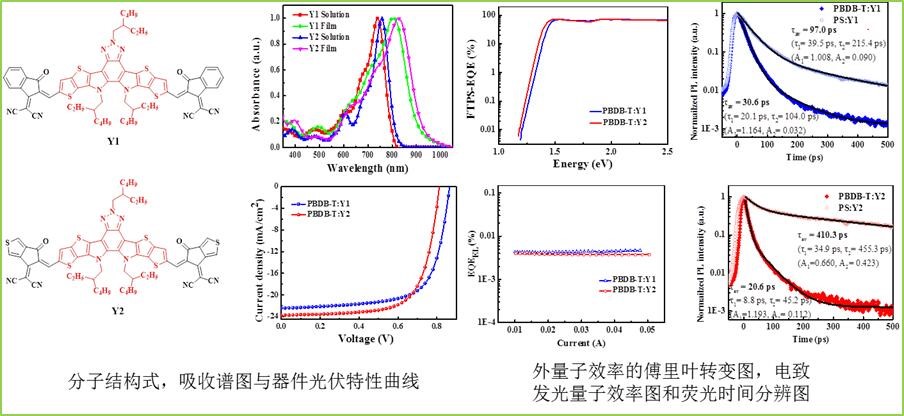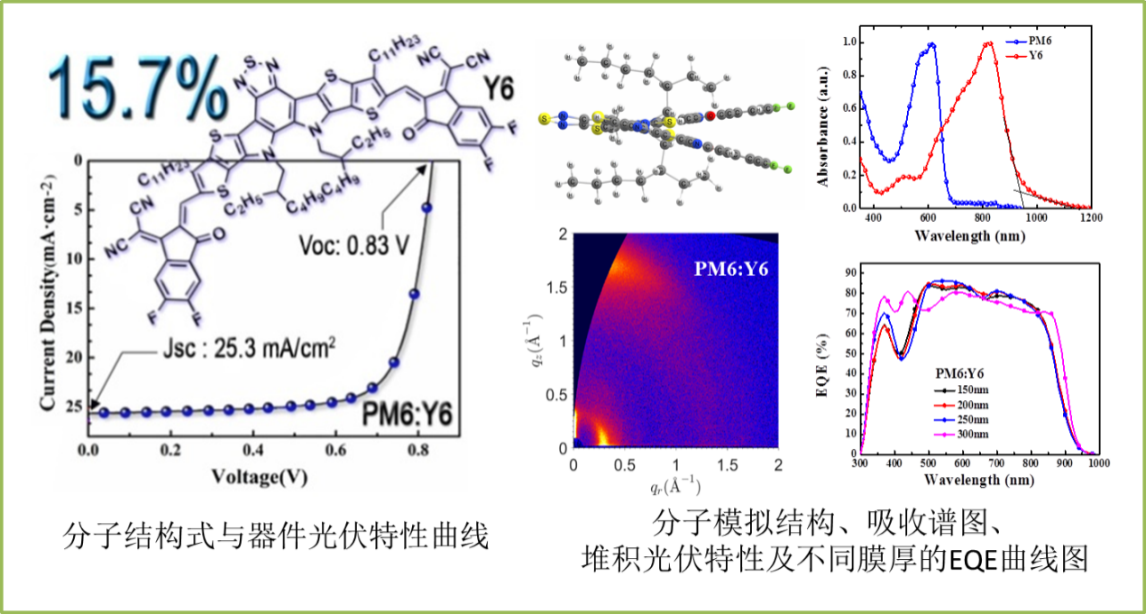Recently, the internationally renowned journalsNature CommunicationsandJoulepublished a series of achievements in design, synthesis and mechanism research of organic solar cell materials of the Research Team of Professor Zou Yingping from the School of Chemistry and Chemical Engineering of CSU.
Organic solar cell is a new type of electronic device that converts solar energy into electrical energy. Owning to its advantages in low preparation cost and easy adjustment of photoelectric characteristics, possibility of being made translucent and applicability to large-area roll-to-roll printing, organic solar cell has become a hot research topic. Themain measure of solar cell performance is its energy conversion efficiency. High-efficiency remains the primary goal of organic solar cell study and is also the key to its industrialization.
The Research Team of Professor Zou Yingping has not only taken into account the energy level matching, absorption spectrum complementarity and mobility equilibrium of organic solar cell materials, but also considered the material compatibility from such perspectives as of thermodynamics and special configuration. In 2017, the Team introduced the electron acceptor unit, benzotriazole, into the central fused-ring core of non-fullerene acceptor for the first time to form a DAD fused-ring structure and then synthesized an organic photovoltaic material based on A-DAD-A type small molecule acceptor. The A-DAD-A type small molecular acceptor can effectively broaden the absorption spectrum and reduce the device voltage loss. This molecular design strategy presents a new thought for material synthesis (ACS Appl. Mater. Interfaces 2017, 9, 31985−31992). Subsequently, with the central core remaining unchanged, the thiophene at both ends of fused-ring was replaced withthieno[3,2-b]thiophene to expand this molecular system from a five-member ring to a seven-member ring; different end groups were changed to synthesize Y1 and Y2 non-fullerene acceptors. Through cooperation with the team of Professor Yang Yang from University of California at Los Angeles (UCLA) and that of Professor Gao Feng from Linkoping University, the Research Team of Zou Yingping has obtained after device optimization the efficiency of 12.6% which was listed in the “Best Cell Efficiency” table of National Renewable Energy Laboratory (NREL) in July 2018.
It has been found, through characterization of materials, that introduction of pyrrole bridge ring and thiophene can broaden the spectral absorption of non-fullerene acceptor molecule, thus significantly increasing the short-circuit current of devices. Introduction of benzotriazole into the central fused-ring core can effectively improve the fluorescence quantum yield of the acceptor molecule. High fluorescence quantum yield contributes to increase in effective channels of radiative recombination, hence improving the electroluminescent quantum efficiency of devices (~ 0.5 x 10-4). The results show that the loss caused by non-radiative recombination can be greatly reduced by introduction of the electron-withdrawing nuclear oftriazole. This work provides a new way to design high-efficiency organic solar cell materials and to reduce the device voltage loss while obtain high short-circuit current simultaneously.
The research achievements were published in theNature Communication, a sub-journal ofNature(Nature Communication, 2019, DOI:10.1038/s41467-019-08386-9). The first author of this paper is Yuan Jun, a doctoral student enrolled at CSU in 2015, who has completed the related work under joint guidance of Professor Zou Yingping, Professor Yang Yang from UCLA and Professor Gao Feng from Linkoping University.

Based on the A-DAD-A type molecular design strategy proposed by the Research Team, after further optimization of molecular structure, the Y6 non-fullerene acceptor has been designed and synthesized by introducing benzothiadiazole with higher electron mobility in place of benzotriazole into the molecular framework and introducing alkyl chain on the β-position of thieno[3,2-b]thiophene to regulate the solubility and molecular conformation. Featuring strong absorption, narrow band gap (1.33 eV) and excellent electron mobility, the molecule has been used to prepare theunijunction organic solar cells (having donor polymer of PM6) with energy conversion efficiency of 15.7% for both forward and reverse devices, which set a new world record of efficiency among unijunction organic solar cells. These achievements play a very important role in promotion of the research on unijunction organic solar cell. One of the bottlenecks in the future large-scale printing and preparation of organic solar cells is the strong dependence of the active layer on the thickness. Generally, the thickness of active layer is limited to 100nm for the optimal energy conversion efficiency of solar cell devices. However, when the thickness of the blend film increases to 300nm, the devices can still maintain the energy conversion efficiency of 13.6%, which is extremely important for the large-area preparation of organic solar cells. Therefore, this work has positive effects on the future industrial production of organic solar cells (roll-to-roll technology).
The research achievements have been published inJoule, the energy flagship journal of Cell Press (Joule, 2019, DOI: 10.1016 / j.j.Oule 2019.01.004). The first author of this paper is Yuan Jun, a doctoral student enrolled at CSU in 2015. Professor Zou Yingping is the corresponding author of this paper. The cooperating units include Institute of Chemistry of Chinese Academy of Sciences (forward device preparation and characterization) and South China University of Technology (reverse device preparation and characterization). CSU is the first unit and the sole corresponding unit.

The research achievements have been commented in the publications includingScience China Chemistryand on the websites of National Natural Science Foundationof China (NSFC), Macromolecular Science, Frontiers in Polymer Science and other websites as a headline subject. Two Chinese patents and one international PCT invention patent have been applied for this research work and it has been jointly funded by the NSFC, Ministry of Science and Technology, Natural Science Foundation of Hunan Province and other organizations.
Related link: http://www.nsfc.gov.cn/publish/portal0/tab434/info75205.htm
Link to paper:https://www.sciencedirect.com/science/article/pii/S2542435119300327;
https://www.nature.com/articles/s41467-019-08386-9
Source: School of Chemistry and Chemical Engineering











